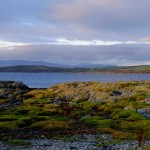Recent literature reviews include Colm O’Brien’s appraisal of the fascinating Early Medieval monastic site at Inchmarnock, off the west coast of the Isle of Bute (Lowe, C. 2008 Inchmarnock: an early historic island monastery and its archaeological landscape. Society of Antiquaries of Scotland, Edinburgh).
 Most of what we know about Inchmarnock comes from a campaign of survey and excavation there which revealed that it was the site of an important monastic school: it has yielded the largest number of inscribed slates from any site in the British Isles. One of these, famously, appears to show a monk kneeling at the feet of a warrior, perhaps asking a Viking for mercy. Eight gaming boards were also found here: clearly the monks were relieving the boredom of long winter evenings on the island by enjoying a game of Nine Men’s Morris, or Merels. Bishops of Kingarth, at the southern tip of Bute, seem also to have spent time here; so the relationship between St Blane’s foundation (near Kingarth) and that on Inchmarnock is intriguing to contemplate: were they competitors for the patronage of the Cenél Comgaill, one of the tribal units of Scottic Dal Riata; or twin aspects of a single entity with one a sort of feeder school for the other?
Most of what we know about Inchmarnock comes from a campaign of survey and excavation there which revealed that it was the site of an important monastic school: it has yielded the largest number of inscribed slates from any site in the British Isles. One of these, famously, appears to show a monk kneeling at the feet of a warrior, perhaps asking a Viking for mercy. Eight gaming boards were also found here: clearly the monks were relieving the boredom of long winter evenings on the island by enjoying a game of Nine Men’s Morris, or Merels. Bishops of Kingarth, at the southern tip of Bute, seem also to have spent time here; so the relationship between St Blane’s foundation (near Kingarth) and that on Inchmarnock is intriguing to contemplate: were they competitors for the patronage of the Cenél Comgaill, one of the tribal units of Scottic Dal Riata; or twin aspects of a single entity with one a sort of feeder school for the other?
The photograph shows Inchmarnock, at dawn, from St Ninian’s chapel on Bute, with Arran looming to the south-west